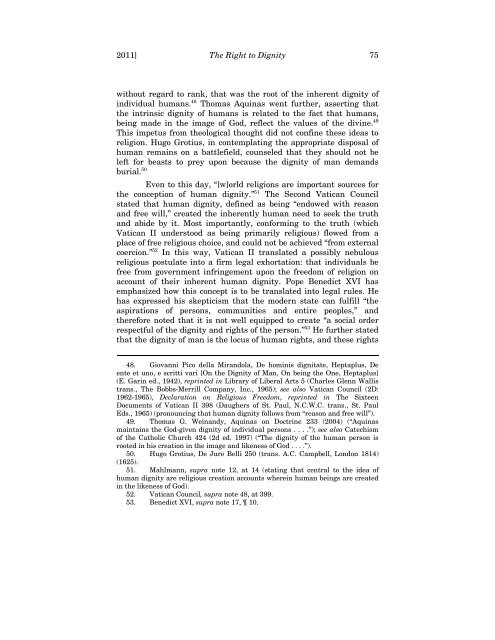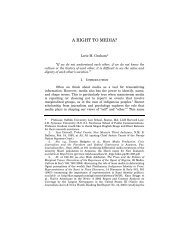The Right to Dignity Rex D. Glensy - Columbia Law School
The Right to Dignity Rex D. Glensy - Columbia Law School
The Right to Dignity Rex D. Glensy - Columbia Law School
You also want an ePaper? Increase the reach of your titles
YUMPU automatically turns print PDFs into web optimized ePapers that Google loves.
2011] <strong>The</strong> <strong>Right</strong> <strong>to</strong> <strong>Dignity</strong> 75<br />
without regard <strong>to</strong> rank, that was the root of the inherent dignity of<br />
individual humans. 48 Thomas Aquinas went further, asserting that<br />
the intrinsic dignity of humans is related <strong>to</strong> the fact that humans,<br />
being made in the image of God, reflect the values of the divine. 49<br />
This impetus from theological thought did not confine these ideas <strong>to</strong><br />
religion. Hugo Grotius, in contemplating the appropriate disposal of<br />
human remains on a battlefield, counseled that they should not be<br />
left for beasts <strong>to</strong> prey upon because the dignity of man demands<br />
burial. 50 Even <strong>to</strong> this day, “[w]orld religions are important sources for<br />
the conception of human dignity.” 51 <strong>The</strong> Second Vatican Council<br />
stated that human dignity, defined as being “endowed with reason<br />
and free will,” created the inherently human need <strong>to</strong> seek the truth<br />
and abide by it. Most importantly, conforming <strong>to</strong> the truth (which<br />
Vatican II unders<strong>to</strong>od as being primarily religious) flowed from a<br />
place of free religious choice, and could not be achieved “from external<br />
coercion.” 52 In this way, Vatican II translated a possibly nebulous<br />
religious postulate in<strong>to</strong> a firm legal exhortation: that individuals be<br />
free from government infringement upon the freedom of religion on<br />
account of their inherent human dignity. Pope Benedict XVI has<br />
emphasized how this concept is <strong>to</strong> be translated in<strong>to</strong> legal rules. He<br />
has expressed his skepticism that the modern state can fulfill “the<br />
aspirations of persons, communities and entire peoples,” and<br />
therefore noted that it is not well equipped <strong>to</strong> create “a social order<br />
respectful of the dignity and rights of the person.” 53 He further stated<br />
that the dignity of man is the locus of human rights, and these rights<br />
48. Giovanni Pico della Mirandola, De hominis dignitate, Heptaplus, De<br />
ente et uno, e scritti vari [On the <strong>Dignity</strong> of Man, On being the One, Heptaplus]<br />
(E. Garin ed., 1942), reprinted in Library of Liberal Arts 5 (Charles Glenn Wallis<br />
trans., <strong>The</strong> BobbsMerrill Company, Inc., 1965); see also Vatican Council (2D:<br />
19621965), Declaration on Religious Freedom, reprinted in <strong>The</strong> Sixteen<br />
Documents of Vatican II 398 (Daughers of St. Paul, N.C.W.C. trans., St. Paul<br />
Eds., 1965) (pronouncing that human dignity follows from “reason and free will”).<br />
49. Thomas G. Weinandy, Aquinas on Doctrine 233 (2004) (“Aquinas<br />
maintains the Godgiven dignity of individual persons . . . .”); see also Catechism<br />
of the Catholic Church 424 (2d ed. 1997) (“<strong>The</strong> dignity of the human person is<br />
rooted in his creation in the image and likeness of God . . . .”).<br />
50. Hugo Grotius, De Jure Belli 250 (trans. A.C. Campbell, London 1814)<br />
(1625).<br />
51. Mahlmann, supra note 12, at 14 (stating that central <strong>to</strong> the idea of<br />
human dignity are religious creation accounts wherein human beings are created<br />
in the likeness of God).<br />
52. Vatican Council, supra note 48, at 399.<br />
53. Benedict XVI, supra note 17, 10.















